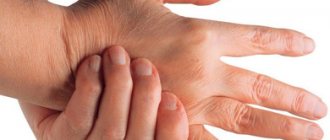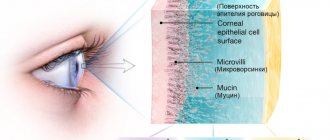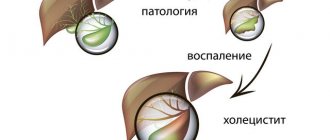Carpal - This word comes from the Greek Karpos, which means "wrist". The wrist is surrounded by bundles of fibrous tissue, which normally serves as a support for the joint. The limited space between these fibrous bands of fibrous tissue and the bony structures of the wrist is called the carpal tunnel. The median nerve, which passes through the wrist, provides sensation to the thumb, index and middle fingers. Any condition that causes swelling or changes in the position of tissue in the wrist can result in compression and irritation of the median nerve. Irritation of the median nerve in such cases leads to tingling and numbness in the thumb, index and middle fingers, a condition known as “carpal tunnel syndrome.”
Causes of carpal tunnel syndrome
Given the limited space in the carpal tunnel, any swelling in this area can put pressure on the median nerve, causing symptoms of carpal tunnel syndrome. There are many different reasons that lead to the development of this syndrome, but often the exact cause cannot be determined. Some people have an anatomically narrower carpal tunnel to begin with, making them more at risk for developing carpal tunnel syndrome. It is believed that this tendency may be genetically determined, and if there is a family history of this syndrome, then the likelihood of pressure on the median nerve increases significantly. You are also more likely to develop carpal tunnel syndrome if you are overweight, smoke, or drink excessively. Another risk factor is age – the older a person is, the higher the likelihood of developing carpal tunnel syndrome. Women are more predisposed to this syndrome than men due to the narrower carpal tunnel. There is also a greater tendency to develop carpal tunnel syndrome if there has been a wrist injury (rupture or sprain) or there are diseases such as:
- diabetes
- osteoarthritis
- rheumatoid arthritis
- hypothyroidism
It is possible that hormones play a role in the development of carpal tunnel syndrome, as some women develop the syndrome during pregnancy or menopause. Hormones produced during pregnancy can lead to fluid retention, which in turn can cause swelling in the wrist. It has been noted that performing certain types of activities can lead to the development of this syndrome. People who do a lot of heavy manual work or repetitive movements of the wrist, such as on an assembly line or working with their hands in cold temperatures, also have a greater risk of developing carpal tunnel syndrome. But the probability increases significantly if the load is combined with the presence of systemic diseases.
When to see a doctor
Do not expect that everything will go away on its own; if you do not consult a doctor in a timely manner, atrophy of the limbs may begin to develop. If your profession involves working at a computer, you stand at a machine for a long time, or you work as a driver, you are at increased risk. When the first symptoms appear (nighttime, vegetative, pain), you need to consult a specialist.
Neurologists at JSC Meditsina (clinic of Academician Roitberg) have extensive experience in treating such problems. Our clinic is located in the center of Moscow, within walking distance are the Mayakovskaya, Belorusskaya, Novoslobodskaya, Tverskaya, and Chekhovskaya metro stations.
Symptoms of Carpal Tunnel Syndrome
Patients with carpal tunnel syndrome initially feel numbness and tingling in the hand along the median nerve (thumb, index, middle, and part of the fourth finger). These sensations are often more pronounced at night and may even lead to awakening from sleep. The cause of increased symptoms at night may be due to the flexed position of the wrist during sleep and/or the accumulation of fluid around the wrist and hand while it is in a horizontal position. Carpal tunnel syndrome may be a temporary condition that resolves completely on its own, or symptoms may persist and progress.
As the syndrome progresses, patients may develop a burning sensation and/or experience hand spasms and weakness. Decreased grip strength can cause objects to frequently fall out of your hand. Sometimes sharp shooting pains can also be felt in the forearm. Chronic carpal tunnel syndrome can also cause muscle atrophy in the hand, especially the muscles at the base of the thumb on the palm of the hand.
Types of tunnel syndrome
The syndrome can manifest itself in several generally accepted forms.
- In the median nerve:
- carpal tunnel syndrome (carpal tunnel, carpal tunnel);
- pronator syndrome (Seyfarth syndrome, “newlywed (honeymoon, lovers) paralysis");
- supracondylar syndrome (Coulomb, Lord and Bedosier syndrome, Straser's band syndrome).
- In the ulnar nerve:
- Guyon's syndrome (Guyon's bed syndrome, ulnar carpal syndrome, compression-ischemic neuropathy of the distal part of the ulnar nerve);
- cubital syndrome (ulnar tunnel syndrome, compression neuropathy of the ulnar nerve in the cubital canal, late ulnar-cubital traumatic palsy).
- In the radial nerve:
- syndrome of compression of the radial nerve in the armpit (“crutch paralysis”);
- syndrome of compression of the radial nerve in the middle of the shoulder (spiral canal syndrome, “Saturday night paralysis”, “park bench”, “bench” syndrome);
- compression syndrome of the radial nerve in the subulnar area (“tennis elbow”, compression neuropathy of the posterior branch of the radial nerve in the subulnar area, supinator syndrome).
Diagnostics
The diagnosis of carpal tunnel syndrome can be made based on symptoms and characteristic areas of numbness in the hand. But at the same time, it is often necessary to exclude other possible causes of symptoms that simulate carpal tunnel syndrome. This could be a neck, shoulder or elbow problem. The doctor examines the wrist to detect swelling, local fever, pain, and discoloration. Sometimes pressing on the front of the wrist can produce a tingling sensation in the hand and this is called the Tinel sign, characteristic of carpal tunnel syndrome. Symptoms may also occasionally be reproduced by flexing the wrist forward (called Phalen's sign). A definitive diagnosis can be made with ENMG. Typically, with carpal tunnel syndrome, there is a slowdown in nerve impulse transmission after the nerve passes through the wrist.
Extremity muscle testing, an electromyogram, is sometimes performed to rule out or detect other conditions that may mimic carpal tunnel syndrome.
Laboratory tests may be performed to help diagnose conditions associated with carpal tunnel syndrome. These tests include thyroid hormone analysis, general blood tests, blood sugar levels, etc. X-rays of the hand may also be ordered to determine the presence of bone changes (abnormalities of the bones and joints of the wrist). MRI is necessary in cases where it is necessary to visualize changes in ligaments and cartilage.
Clinical manifestations
The full picture of tunnel syndrome includes sensory (pain, paresthesia, numbness), motor (decreased function, weakness, atrophy) and trophic disorders.
Various clinical course options are possible. Most often it starts with pain or other sensory disorders. Less commonly, it begins with movement disorders. Trophic changes are usually expressed insignificantly and only in advanced cases. The most characteristic feature of carpal tunnel syndrome is pain. Typically, pain appears during movement (load), then occurs at rest. Sometimes the pain wakes the patient up at night, which exhausts the patient and forces him to see a doctor. Pain in tunnel syndromes can include both a nociceptive component (pain caused by inflammatory changes occurring in the area of the nerve-canal conflict) and a neuropathic component (due to nerve damage). Tunnel syndromes are characterized by manifestations of neuropathic pain such as allodynia and hyperpathy, a sensation of electric current passing (electrical shooting), and burning pain. In later stages, pain may be due to muscle spasms. Therefore, when choosing pain therapy, it is necessary to be guided by the results of a thorough clinical analysis of the characteristics of the pain syndrome. Motor disorders arise as a result of damage to the motor branches of the nerve and manifest themselves in the form of decreased strength and rapid fatigue. In some cases, the progression of the disease leads to atrophy and the development of contractures (“clawed paw”, “monkey paw”).
With compression of arteries and veins, vascular disorders may develop, which is manifested by pallor, a decrease in local temperature, or the appearance of cyanosis and swelling in the affected area. With isolated nerve damage (in the absence of compression of arteries and veins), trophic changes are most often insignificantly expressed.
Treatments for carpal tunnel syndrome
The choice of treatment for carpal tunnel syndrome depends on the severity of the symptoms and the underlying medical condition that may be causing the symptoms.
In the first stage, treatment usually includes rest, immobilization of the wrist in a brace, and sometimes local cold. If the patient’s profession involves stress on the wrist, then it is necessary to change activities for a while. In addition, it is possible to improve the ergonomics of the workplace, for example, you can adjust the computer keyboard and the height of the chair and optimize the load on the hands. These measures, as well as periodic episodes of rest and wrist stretching exercises, can actually prevent the development of carpal tunnel syndrome symptoms, which are caused by repetitive, excessive movements of the wrist. If there are systemic diseases or injuries, then individual treatment of these diseases is carried out. Fractures may require orthopedic correction (plaster, orthosis). Overweight patients should be advised to lose weight. For rheumatoid arthritis, specific treatment is carried out for the inflammatory autoimmune process. Wrist swelling, which may be associated with pregnancy, disappears after the baby is born.
Drug treatment
Several types of medications may be used to treat carpal tunnel syndrome. Vitamin B6 (pyridoxine) is quite often prescribed in the treatment of carpal tunnel syndrome and, although the mechanism of therapeutic action is not entirely clear, nevertheless, many doctors note a certain effect of using this drug. Nonsteroidal anti-inflammatory drugs may also be helpful in reducing inflammation and pain. But these drugs have side effects and therefore this must be taken into account when prescribing them. Corticosteroids may also be used. They can be given orally or as injections into the affected wrist joint. Corticosteroids can lead to rapid relief of symptoms, but the side effects of these drugs do not allow them to be prescribed long-term and in the presence of some conditions (for example, in diabetes mellitus, their use can lead to a worsening of the condition). They should also not be prescribed in the presence of infections. In addition to drug treatment, physiotherapy and acupuncture also provide a certain therapeutic effect. Most patients with carpal tunnel syndrome can be treated with conservative therapy. But sometimes chronic pressure on the median nerve can lead to permanent numbness and weakness. To avoid serious and permanent nerve and muscle damage, surgical treatment may be recommended in such cases. Surgery involves excision of tissue putting pressure on the median nerve. This surgical procedure is called a "carpal tunnel release." Currently, such an operation can be performed using endoscopic techniques, which allows for minimal tissue trauma and rapid restoration of nerve conduction. After surgical treatment, it is necessary to use exercise therapy to restore hand function.
Medications for carpal tunnel syndrome
To reduce inflammation, patients are recommended to receive corticosteroid injections (usually into the carpal tunnel). Tablets are less effective in relieving inflammation, although they are also available in pharmacies. The effect does not occur immediately - the pain begins to subside only after 2 days, and before that it can, on the contrary, intensify.
But even with a positive result of treatment, symptoms sometimes reappear after a few months. If this happens, a new dose of corticosteroids is prescribed. Subsequent use of these drugs may cause long-term side effects, so further use is not recommended.
Aspirin, ibuprofen and similar non-steroidal anti-inflammatory drugs can reduce short-term pain. Their use is advisable only when the syndrome occurs due to an inflammatory process. If the cause of the disease is excessive activity of the hand, this option will not help.
Other treatment methods include Botox injections and special exercises.









